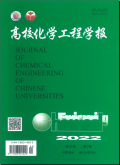高校化学工程学报2012,Vol.26Issue(3):374-381,8.
响应面优化法在PDMS/PVDF膜制膜条件优化中的应用
Application of Response Surface Methodology(RSM) to Optimize the Preparation Conditions of PDMS/PVDF Composite Membranes
摘要
Abstract
The response surface methodology (RSM) was used to optimize the preparation conditions of PDMS/PVDF composite membranes for pervaporation. The effects of four variables including silicone rubber concentration, mass ratio of RTV B to RTV A, cross-linking temperature and time on the membrane performances were investigated. The regression equations between the preparation variables and the performances of the composite membranes were established, and the main effects, quadratic effects and the effects of interactions of the four variables on the separation factor and permeation flux of the composite membranes were studied. It was found that the silicone rubber concentration affects the selectivity and permeation flux of the composite membranes prepared most significantly, while the cross-linking time has almost no effect on the selectivity. According to the optimization analysis of the proposed regressing equation, it was found that, at 40℃ and ethanol concentration of 10%(wt) and when the silicone concentration is 93%(wt), the mass ratio of RTV B to RTV A is 0.08, cross-linking temperature is 100℃ and cross-linking time is 13.83 h, the prepared PDMS/PVDF composite membrane will have the optimum performances of selectivity of 9.47, total flux of 77.57 g·(m2·h)-1 and the ethanol concentration of the permeate side is 51.3%. The experimental results are in good agreement with those predicated by the proposed regression equation, which indicates that the proposed regression equation could be used to forecast and optimize the pervaporation performance of the PDMS/PVDF composite membrane to be prepared.关键词
PDMS/星点设计/响应面优化法/渗透汽化/透醇膜Key words
PDMS/ central composite design/ response surface methodology/ pervaporation/ ethanol-selective membrane分类
化学化工引用本文复制引用
樊铖,展侠,陈剑,潘福生,秦琳,王涛,李继定..响应面优化法在PDMS/PVDF膜制膜条件优化中的应用[J].高校化学工程学报,2012,26(3):374-381,8.基金项目
国家973项目(2009CB623404) (2009CB623404)
国家自然科学基金项目(20736003). (20736003)

